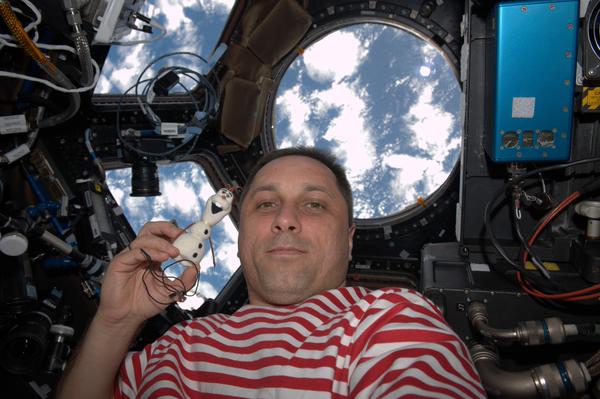'Frozen' in Space! Olaf the Snowman Floats in Zero-G (Photos)

It's one giant leap for snowman-kind: Olaf, the goofy snowman from Disney's hit film "Frozen," is floating aboard the International Space Station, and we have the photos to prove it.
Russian cosmonaut Anton Shkaplerov brought the small, stuffed Olaf toy into space as his mission's "zero-g indicator" at the request of his 8-year-old daughter when he launched on a mission to the International Space Station. Shkaplerov and two crewmates blasted off aboard their Soyuz capsule on Nov. 24 and arrived at the orbiting outpost six hours later. On Tuesday (Dec. 9), Shkaplerov posted a photo on Twitter of Olaf floating serenely in the many-windowed observation deck of the station.

Every Soyuz flight includes a "zero-g" indicator, which is often a toy of some kind selected by the Soyuz commander and crew. The indicator is hung by a string in a place where the crew can see it during launch. (Notice the string tied around Olaf in the images, suggesting Shkaplerov doesn't truly want to "let it go".) When the object becomes weightless and begins to float, it confirms that the crew is in orbit.
Olaf joins a long line of toys in space that have been launched into orbit over the years. Those intrepid toy explorers include Hello Kitty, Legos, Smokey the Bear, a stuffed hippopotamus and a red Angry Bird (which NASA astronaut Don Pettit used to make his own version of Angry Birds in space).
"Frozen" is the highest-grossing animated movie of all time and can truly be said to have reached new heights: 250 miles (402 kilometers) above the Earth, to be exact. The second-highest-grossing animated film of all time, "Toy Story 3," also had a character aboard the station: an action figure of Buzz Lightyear took a ride on NASA's space shuttle Discovery in 2008.
Shkaplerov arrived at the orbiting laboratory on Nov. 24, alongside NASA astronaut Terry Virts and European Space Agency astronaut Samantha Cristoforetti. They join NASA's Barry Wilmore and cosmonauts Alexander Samokutyaev and Elena Serova as part of the Expedition 42 crew. Rotating crews of astronauts have continuously lived aboard the $100 billion International Space Station since 2000.
Follow Calla Cofield @callacofield. Follow us @Spacedotcom, Facebook and Google+. Original article on Space.com.
Get the Space.com Newsletter
Breaking space news, the latest updates on rocket launches, skywatching events and more!
Join our Space Forums to keep talking space on the latest missions, night sky and more! And if you have a news tip, correction or comment, let us know at: community@space.com.

Calla Cofield joined Space.com's crew in October 2014. She enjoys writing about black holes, exploding stars, ripples in space-time, science in comic books, and all the mysteries of the cosmos. Prior to joining Space.com Calla worked as a freelance writer, with her work appearing in APS News, Symmetry magazine, Scientific American, Nature News, Physics World, and others. From 2010 to 2014 she was a producer for The Physics Central Podcast. Previously, Calla worked at the American Museum of Natural History in New York City (hands down the best office building ever) and SLAC National Accelerator Laboratory in California. Calla studied physics at the University of Massachusetts, Amherst and is originally from Sandy, Utah. In 2018, Calla left Space.com to join NASA's Jet Propulsion Laboratory media team where she oversees astronomy, physics, exoplanets and the Cold Atom Lab mission. She has been underground at three of the largest particle accelerators in the world and would really like to know what the heck dark matter is. Contact Calla via: E-Mail – Twitter









